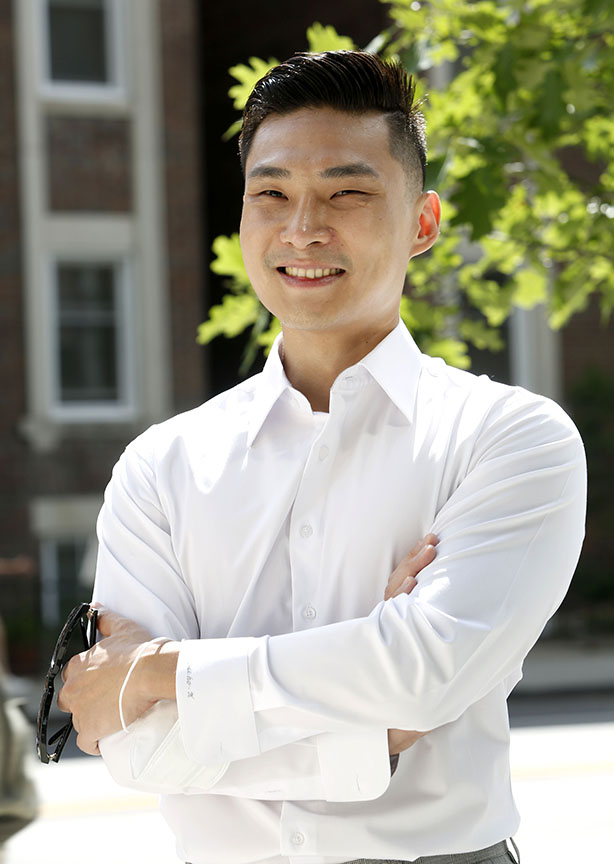
(Photo: Phill Snel, CivMin)
Daeho Kim joins the Department of Civil & Mineral Engineering as an assistant professor of civil engineering (Construction) beginning July 1, 2021.
We asked Prof. Kim to answer a few questions as an introduction to our CivMin community.
Q: Can you tell us a little about yourself as an introduction.
I originally came from Seoul, South Korea. My academic journey started from the year 2006 at Yonsei University in South Korea. At there, I got my bachelor’s and master’s degree in Architectural Engineering. I went to the University of Michigan in 2016 and started a new academic journey in Civil engineering (MSc and PhD), exploring a new horizon of construction—co-robotic construction.
Q: Could you explain the focus of your research?
My research focus is to widen the horizon in construction by realizing the true value of co-robotic construction. My goal as a researcher is to lay a solid foundation for human-robot collaboration by establishing safe and cohesive teaming among workers and robots and reconfiguring the existing labor-intensive construction mechanism.
As you know, the construction industry is gradually gearing up to embrace a range of robotic solutions (please see this example, SAM: https://www.youtube.com/watch?v=MVWayhNpHr0) to break through the sustained suffering from low productivity, poor safety, and the shortage of skilled young laborers. Equipment manufacturers have retrofitted their equipment with autonomous kits, and robotics companies are releasing a variety of construction robots at varying degrees of autonomy. Swimming with the tide, the construction academia is exploring new forms of robotic solutions. Imagine the successful deployment of robotic solutions. Robots will carry out repetitive and laborious tasks quickly, while workers can instead focus on supervising robots or troubleshooting uncertainties. It is not so hard to guess such synergy from the cohesive human-robot collaboration would greatly improve the project’s productivity as well as workers’ ergonomics and safety. This innovation will also be a key driver to make construction jobs more intellectual and attractive to prospective workers from various range of demographics.
Promising it may be, it is questionable whether the construction industry is ready to embrace robotic solutions. We need scalable safety technologies at high fidelity, redesign of workspace and work process, and the development of training programs for human workers who are to co-work with robots. Accordingly, my four research agendas are searching answers to the following questions: (i) first, how to ensure workers’ safety alongside robots at varying autonomy; (ii) second, how to improve workers’ physical, cognitive, and emotional comforts alongside robots, thereby having more productive and cohesive teaming between them; (ii) third, what the ideal work environment would it be not for human or robot, but for a human-robot crew; and (iv) fourth, how to foster a new workforce specialized in robot collaboration.
During my PhD, I worked mainly on the framework and technology development to ensure workers’ safety alongside robots, leveraging visible, imagery data, computer vision, and deep neural networks. In the future, I intend to explore the rest of the agendas by expanding our
knowledge and skillset to a variety of sensing modalities and learning techniques. Hope you find this interesting.
Q: Why did you choose U of T?
To answer this question, I would like to first share with you my research philosophy in construction. If I have to put it in a word, it would be practicality. I believe the value of research can truly shine when it is applied to the real world and address what the real field struggles with.
To attain practicality in research, having continued interaction with industry partners, hearing their voices and needs, and validating research at real construction sites are of great importance. Toronto, one of the largest cities in North America and the hub of a wide spectrum of construction projects, will provide me with such opportunities.
Last but not least, the other reason why I chose UoT is the ample opportunity for interdisciplinary research. To contribute to construction management, I am eager to embrace arising sensing modalities and advanced data analytics from the various domains and bridge the interdisciplinary gap. Where a better choice would there be than UoT—inarguably the top university in Canada having a rich set of academic professionals?
Q: What are you most looking forward to in your new position?
I am looking forward to meeting you all and getting to know more about you! I am a very open-minded and easy-going person. Anyone who knocks on my door will be very welcomed. I will have coffee ready in my office all the time.
Q: As a new professor, what one piece of advice would you give to new students?
Keep challenging and don’t be afraid of failures. Learning new knowledge, having new skillsets, and finally being an expert: none of these is straightforward and you may face difficulties. But don’t think of them as failures and think positive. Think you fell forward, not backward. Learning and progress are there in failure, sometimes even bigger than that of success.
Q: What do you hope to accomplish in your new position/during your time at U of T Engineering?
Apart from research and teaching, there is a thing that I would like to accomplish— which is, rebranding Civil Engineering! Construction, an industry that provides buildings and infrastructure essential to our daily lives, is one of the largest and important industries for society. Nevertheless, construction jobs are often considered as low-compensation occupations, and a portion of young construction professionals and students is sadly declining. I would like to challenge the pervaded pessimism and rebrand our department, stepping forward to the new paradigm of construction—more automated and digitalized co-robotic construction.
Q: Finally, is there anything fun/unusual/unexpected about yourself you’d like to share with our CivMin audience?
I have a special experience of teaching not in academia, but in the military. I trained 3,600 soldiers when I served military service in South Korea as a drill sergeant for two years!